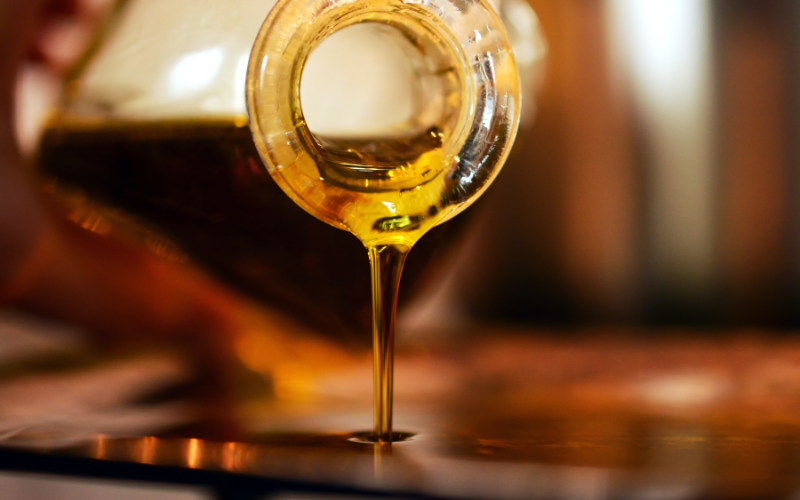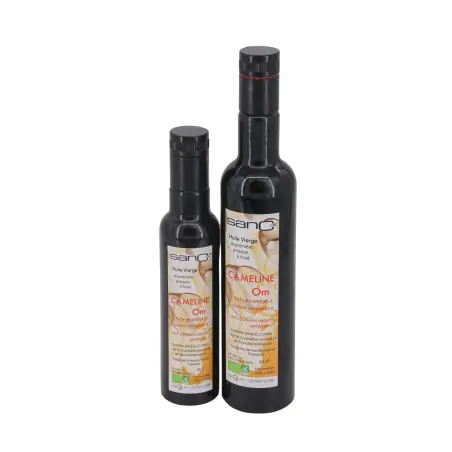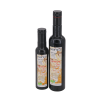We were pleasantly surprised to discover that a couple of producers living nearby (we live in the Vaunage area of Gard, less than 10 km from them!) were producing camelina oil. of incredible quality, in true first cold pressing. Organic camelina oil is experiencing a remarkable resurgence of interest among consumers who are concerned about their health and the environment. This vegetable oil exceptional, derived from the seeds of the plant Camelina sativa, , is distinguished by its exceptional richness in essential fatty acids, including omega-3s, and its unique nutritional benefits. Discover in this article why this ancient oil deserves a special place in your daily diet and how artisanal cold pressing preserves all its benefits.
What is organic camelina oil ?
Camelina, also known as "the bastard line" or "sesame from Germany", is an oilseed plant of the botanical family of Brassicaceae. Cultivated since the Bronze Age, this hardy plant was once widely widespread in Northern Europe and in Central Asia before falling into oblivion in favor of other oilseeds. Today, it is making a big comeback thanks to its exceptional nutritional qualities and its ability to adapt to difficult climatic conditions.
Organic camelina oil is obtained by cold pressing of seeds, part of the plant used in this artisanal process that fully preserves its nutritional properties. This gentle extraction method, without heating or chemical solvents, ensures a Oil Premium virgin, rich in essential nutrients and natural antioxidants.
Exceptional nutritional composition of camelina oil
Omega-3 fatty acid profile
Camelina oil is distinguished by its remarkable lipid composition. It contains 33 to 40% of aalpha-linolenic acid (ALA), an essential omega-3 fatty acid that our body cannot synthesize. This exceptionally high content makes it one of the best plant sources of omega-3, even surpassing thelinseed oil in some cases.
The distribution of unsaturated fatty acids in camelina oil is particularly balanced:
- Omega-3 (ALA): 35-40%
- Omega-6 (linoleic acid): 15-20%
- Omega-9 (oleic acid): 12-15%
And: Saturated fatty acids: 8-12%
Natural antioxidants and vitamin E
Organic camelina oil naturally contains several forms of vitamin E (tocopherols), , notably the gamma, , delta and Alpha-tocopherols. These natural antioxidants give it remarkable stability and protective properties for the body. The concentration of vitamin E in camelina oil exceeds that of most other vegetable oils, including rapeseed oil., sunflower and linen.

The scientifically proven benefits of camelina oil
Cardiovascular protection and cholesterol regulation
Scientific research shows that regular consumption of camelina oil significantly contributes to cardiovascular health. Alpha-linolenic acid (ALA) it contains plays a crucial role in reducing cardiovascular risk factors.
A Finnish study conducted by The University of Finland orientale compared the effects of consuming camelina oil (30 ml per day) to that of fatty fish over a period of 12 weeks. The results showed that camelina oil was as effective as fatty fish in improving the blood lipid profile and reducing systemic inflammation.
The mechanisms of action of ALA on the cardiovascular system include:
- Reduction of blood triglycerides
- Improvement of the HDL/LDL ratio cholesterol
- Reduction of vascular inflammation
- Improvement of endothelial function
Anti-inflammatory properties
Low-grade chronic inflammation is involved in many modern pathologies. Camelina oil, due to its richness in omega-3, exerts powerful anti-inflammatory effects. ALA is converted in the body into active metabolites (EPA and DHA) that modulate the production of inflammatory mediators.
A randomized clinical study published in International Journal of Clinical Practice demonstrated that supplementation with camelina oil in patients with non-alcoholic fatty liver disease (NAFLD) significantly reduced inflammatory markers while improving glucose homeostasis.
Metabolism support and glycemic control
Camelina oil offers remarkable metabolic benefits, particularly for individuals with insulin resistance or metabolic syndrome. The omega-3s it contains improve insulin sensitivity and promote better regulation of Blood sugar.
The mechanisms involved include:
- Improvement of insulin signaling
- Reduction of oxidative stress
- Modulation of inflammation in adipose tissues
- Optimization of hepatic metabolism
Benefits for brain and cognitive health
Alpha-linolenic acid plays a fundamental role in the development and maintenance of brain functions. It contributes to the structure of neuronal membranes and participates in the synthesis of essential neurotransmitters. Regular consumption of camelina oil can therefore support:
- Cognitive function
- The memory and learning
- Protection against age-related cognitive decline
- Brain development in children
Dermatological properties and skin beauty
Organic camelina oil also has applications cosmetics remarkable. Its composition of essential fatty acids makes it a preferred treatment for:
- Deep skin hydration
- Strengthening the skin barrier
- Soothing sensitive and irritated skin
- Prevention of skin aging
- Maintaining the elasticity of the skin
Cold pressing: a guarantee of quality and purity
Cold pressing principle
Cold pressing is a mechanical extraction method that fully preserves the nutritional qualities of camelina oil. This ancient technique involves applying pressure to the seeds without heating, allowing for the production of virgin oil with optimal organoleptic and nutritional properties.
Advantages of cold pressing
This extraction method has many advantages:
Nutrient preservation Low temperatures (below 40°C) preserve fragile polyunsaturated fatty acids and natural antioxidants.
Absence of chemical solvents : Unlike industrial methods, cold pressing does not use any synthetic solvents, ensuring a 100% natural oil.
Preservation of aromas : The oil retains its subtle flavor notes and its authentic nutty taste.
Natural stability : The preservation of natural tocopherols gives the oil better resistance to oxidation.
Sanctum Mediterranean: The Excellence of French Terroir
Sanctum Mediterranean embodies French excellence in the production of organic camelina oil. This family business, located in the south of France, develops an innovative approach to theAgriculture sustainable by valuing traditional know-how and resources from the Mediterranean region.
Commitment to biodiversity
Sanctum Méditerranée is actively committed to preserving biodiversity by cultivating ancient varieties and promoting agroecological practices. Their holistic approach includes:
- The selection of seeds suited to the terroir
- Environmentally friendly agricultural practices
- The valorization of companion plants
- The preservation of local ecosystems
Traceability and transparency
From seed to finished product, Sanctum Méditerranée ensures complete traceability of its productions. This transparent approach guarantees consumers:
- The French origin of raw materials
- Compliance with organic specifications
- The consistent quality of the products
- The authenticity of manufacturing processes
Use and dosage of camelina oil
Food consumption
Organic camelina oil is preferably consumed raw to preserve its nutritional properties. It can be used:
- As a seasoning for salads and raw vegetables
- As a finishing touch on cooked vegetables
- Blended with other oils to balance the flavors
- In smoothies and cold preparations
The recommended dose is 1 to 2 tablespoons per day for an adult, approximately 15 to 30 ml.
Optimal conservation
To preserve all its qualities, organic camelina oil must be stored:
- Out of the light
- In a cool place (room temperature)
- In a hermetically sealed bottle
- Consume within 6 months after opening

Environmental impact and sustainability
Ecological cultivation of camelina
Camelina offers numerous environmental benefits that make it a crop of the future:
Natural resistance : This hardy plant requires few inputs and is naturally resistant to pests and diseases.
Climate adaptation : It adapts to harsh climatic conditions and poor soils, reducing the need for irrigation.
Crop rotation Camelina integrates perfectly into rotation systems, improving soil structure and fertility.
Biodiversity : Its prolonged blooming supports pollinators and contributes to local biodiversity.
Reduced carbon footprint
The local production of camelina oil by players like Sanctum Méditerranée helps to reduce carbon footprint consumers in:
- Limiting international transportation
- Favoring short supply chains
- Reducing packaging
- Supporting the local economy
Camelina oil in a modern diet
Integration into the daily diet
Organic camelina oil easily integrates into a modern and balanced diet. It meets current nutritional needs by providing:
- Bioavailable plant-based omega-3s
- An alternative to conventional oils
- A subtle and pleasant taste
- A versatility of use
Complementarity with other oils
To optimize the intake of fatty acids, camelina oil can be combined with other quality oils:
- Olive oil for omega-9
- Rapeseed oil for omega-3/omega-6 balance
- Walnut oil to diversify sources of ALA
Future prospects and emerging research
Scientific research continues to explore the therapeutic potentials of camelina oil. The current areas of investigation include:
Prevention of neurodegenerative diseases
Preliminary studies suggest that omega-3s from camelina oil may play a protective role against certain neurodegenerative diseases, thanks to their anti-inflammatory and neuroprotective properties.
Applications in preventive medicine
The integration of camelina oil into preventive medicine protocols is the subject of promising research, particularly for:
- Cardiovascular prevention
- Management of metabolic syndrome
- Immune support
- Digestive health
Agri-food innovation
The agri-food industry is exploring new applications of camelina oil in:
- Functional foods
- Dietary supplements
- Infant nutrition products
- Cosmetic formulations
Conclusion: An exceptional healthy choice
Organic camelina oil represents an exceptional nutritional choice for anyone looking to optimize their health while respecting the environment. Its exceptional richness in omega-3, its antioxidant properties, and its scientifically proven benefits make it a valuable ally for cardiovascular, brain, and overall health.
The commitment of French producers like Sanctum Méditerranée to a sustainable and transparent approach ensures consumers a superior quality product that respects the land and the environment. By choosing cold-pressed organic camelina oil, you are opting for a conscious diet that is beneficial for your health and that of the planet.
Organic camelina oil is therefore emerging as a modern superfood, combining ancient tradition with contemporary nutritional science. Incorporating it into your daily diet is a sustainable investment in your well-being and vitality.
Frequently Asked Questions (FAQ)
1. What is the difference between camelina oil and linseed oil ?
Camelina oil offers several advantages over flaxseed oil. Although both are rich in omega-3 (ALA), camelina oil is more stable due to its naturally high content of vitamin E and antioxidants. It also has a milder taste and better shelf life. Camelina oil contains 35-40% omega-3 compared to 50-60% for flaxseed oil, but its superior stability makes it a more practical choice for daily use.
2. How to consume organic camelina oil to maximize its benefits ?
To maximize the benefits of organic camelina oil, consume it raw, at a rate of 1 to 2 tablespoons per day (15-30 ml). Use it as a salad dressing, as a finishing touch on cooked vegetables, or mixed into smoothies. Avoid heating it to preserve its fragile polyunsaturated fatty acids and natural antioxidants.
3. Is organic camelina oil suitable for children and pregnant women ?
Yes, organic camelina oil is perfectly suitable for children and pregnant women. It does not present any particular contraindications according to health authorities, including the FDA. Its omega-3s are even beneficial for brain and nervous system development in children and fetuses. For children, adjust the dose: 1 teaspoon per day is generally sufficient.
4. How long does organic camelina oil last after opening ?
Organic camelina oil can be stored for about 6 months after opening if kept under proper conditions: away from light, at room temperature, in a tightly sealed bottle. Its natural richness in vitamin E gives it better stability than other oils rich in omega-3. Regularly check for any signs of rancidity (unpleasant smell or taste).
5. Can you cook with organic camelina oil ?
It is not recommended to cook at high temperatures with organic camelina oil because the heat destroys its valuable omega-3s and antioxidants. It is ideal for cold preparations and can be added as a finishing touch to warm dishes. For cooking, opt for more stable oils like olive or coconut oil, and add camelina oil after cooking.
Scientific References
- Chiu, S., Klein, R., Milton, R. C., Gensler, G., & Taylor, A. (2009). Does omega-3 fatty acid supplementation suppress diabetic retinopathy? Review of the evidence to date. . Ophthalmology, 116(12), 2336-2349.
- Gogus, U., & Smith, C. (2010). n-3 Omega fatty acids: a review of current knowledge. . International Journal of Food Science & Technology, 45(3), 417-436.
- Health Canada. (2015). Camelina Oil - Novel Food Information. Gouvernement du Canada.
- Musazadeh, V., Zarezadeh, M., Faghfouri, A. H., et al. (2021). Omega 3-rich Camelina sativa oil in the context of a weight loss program improves glucose homeostasis, inflammation, and oxidative stress in patients with NAFLD: A randomized placebo-controlled clinical trial. . International Journal of Clinical Practice, 75(8), e14273.
- Schwab, U., Callaway, J., Erkkilä, A., Gynther, J., Uusitupa, M., & Järvinen, T. (2006). Effects of hempseed and flaxseed oils on the profile of serum lipids, serum total and lipoprotein lipid concentrations and haemostatic factors. . European Journal of Nutrition, 45(8), 470-477.
- Siniarska, A., Wolosiak, R., Brandt, K., et al. (2020). Development of omega-3-rich Camelina sativa seed oil emulsions. . Food Science & Nutrition, 8(4), 1734-1744.
- Zubr, J. (1997). Oil-seed crop: Camelina (Camelina sativa L. Crantz). . Cultures industrielles et produits, 6(2), 113-119.












